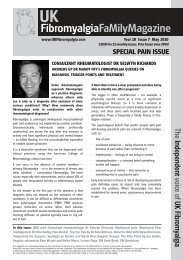DECEMBER 2009 FAMILY - UK Fibromyalgia
DECEMBER 2009 FAMILY - UK Fibromyalgia
DECEMBER 2009 FAMILY - UK Fibromyalgia
Create successful ePaper yourself
Turn your PDF publications into a flip-book with our unique Google optimized e-Paper software.
References:<br />
• Edwards AM, Blackburn L, Christie S, Townsend<br />
RGN, David J. Food supplements in the treatment<br />
of fibromyalgia: a double- blind, crossover trial of<br />
anthocyanidins. J Nutrition Environ Med 2000;<br />
10:189-99.<br />
Classification:<br />
Effectiveness score: 1<br />
Safety classification: Amber<br />
Anthocyadins<br />
Description of the compound: A<br />
subgroup of flavonoids, which are<br />
chemicals derived from non-nutritive<br />
components of some plants.<br />
Mechanism of action: Several studies in<br />
the laboratory have shown that<br />
anthocyanidins can act as strong antioxidants<br />
(i.e. can prevent cell damage in<br />
the body by interacting with harmful<br />
molecules produced within the cells<br />
known as free radicals). Anthocyanidins<br />
can also prevent the destruction of<br />
collagen in the muscles, a problem that<br />
has been observed in some patients with<br />
fibromyalgia.<br />
Safety and toxicity: Reported adverse<br />
effects on short-term usage include<br />
stomach upset, skin rash and problems in<br />
passing urine. There are no reports on the<br />
long-term safety of anthocyanidins.<br />
Availability: The compound is available<br />
over-the-counter in pharmacies in the<br />
form of capsules (Colladeen®). This<br />
dietary supplement can also be ordered<br />
via the internet.<br />
Interactions: Interactions with other drugs<br />
have not been well studied.<br />
Dosage: Doses ranging from 40mg/day to<br />
120mg/day have been used in a previous<br />
randomised controlled study. No trials<br />
have been conducted to establish<br />
appropriate dosage in musculoskeletal<br />
conditions.<br />
The role in treatment of arthritis and<br />
musculoskeletal conditions:<br />
One small RCT was conducted to evaluate<br />
the role of anthocyanidins in treating<br />
patients with fibromyalgia. In this trial, 12<br />
patients with fibromyalgia were<br />
randomised to receive one of the<br />
following three daily doses of<br />
anthocyanidins (120mg, 80mg,<br />
40mg/day) or placebo tablets for three<br />
months. All patients in this trial were<br />
asked to report daily the severity of their<br />
pain and the degree of fatigue and sleep<br />
problems in a diary. The degree of<br />
improvement in pain, fatigue and sleep<br />
were also evaluated by the investigator by<br />
interviewing the patients once every<br />
month. Anthocyanidin was not effective<br />
in reducing pain (as evaluated by the<br />
patient and the investigator) at any daily<br />
doses during any part of the follow-up. A<br />
similar lack of effect on fatigue was also<br />
reported by patients, although some<br />
beneficial effect was observed by the<br />
investigators during the interview.<br />
Based on patients’ daily reports in diaries,<br />
a significant reduction in sleep<br />
disturbance was reported by patients<br />
who were taking anthocyanidins<br />
compared to patients on the placebo.<br />
However, such beneficial effects on sleep<br />
pattern were not confirmed by the<br />
investigators during the interviews.<br />
Patients who were on anthocyanidins<br />
reported more adverse effects (stomach<br />
upset, skin rash and urinary disturbance)<br />
than those who were allocated placebo<br />
capsules.<br />
Conclusion: Anthocyanidins are a<br />
subgroup of flavonoids with strong antioxidant<br />
properties that can theoretically<br />
support and prevent the destruction of<br />
collagen in muscles. The effectiveness of<br />
these food supplements in the treatment<br />
of patients with fibromyalgia was only<br />
tested in one small RCT, in which no<br />
reduction in pain and an unconfirmed<br />
improvement in fatigue and sleeping<br />
problems were found. The limited data<br />
available does not yet allow for reliable<br />
evaluation of the role of this treatment for<br />
fibromyalgia.<br />
Capsaican gel<br />
Family: Herbal medicine extracted from<br />
chilli peppers (Genus Capsicum family).<br />
Scientific name: Capsaicin.<br />
Other names: Axsain®, Zacin®, chilli,<br />
pepper gel, cayenne.<br />
Description of the compound:<br />
Capsaicin, which is the main medicinally<br />
active component of chilli peppers, is<br />
extracted from the placental tissue and<br />
internal membranes of the plant.<br />
Mechanism of action: Several studies<br />
have found that capsaicin can deplete<br />
Substance P, which plays an important<br />
role in the transmission of pain signals<br />
from nerve endings to the brain and is<br />
involved in activating inflammatory<br />
substances in joints.<br />
Safety and toxicity: There are no major<br />
safety concerns in topical application of<br />
capsaicin gel/cream. Most patients will<br />
feel a burning sensation when the gel<br />
comes<br />
into contact with their skin. This is<br />
because capsaicin also binds to specific<br />
receptors in nerve endings called VR1,<br />
producing a burning sensation, which is<br />
not caused by any tissue damage. Brief<br />
redness of the skin is common, but high<br />
doses of capsaicin can cause skin<br />
blisters. It is important to keep capsaicin<br />
away from the eyes, mouth and open<br />
wounds as it is highly irritant.





